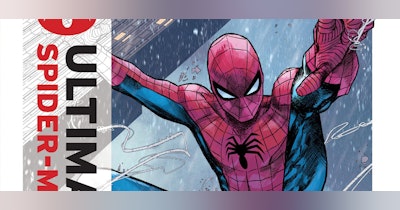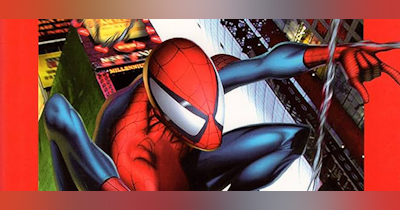Much of these reviews were originally published on The Latest Pull, a website dedicated to geek culture that I once wrote for. Some information was left out to keep the content consistent with site standards, but that information has been reinstated here (and any changes I've made from the original review have been clearly identified).
This week I want to talk about two wildly different series being published at the same time. Ms. Marvel and Revival, two comics published by different companies with no creator overlap that are drastically different in tone. Yet, somehow, I want to talk about what these comics mean in relation to each other and to the overall comic book industry.
Ms. Marvel has been a shining example of how entertaining family-friendly superhero comics can be.
Revival, on the other hand, has given readers plots involving dismemberments, murder, psychosis, and incest. Yet every month I line up (sit down) at the door (computer screen) for the inevitable release of the newest installments of both of these properties. This month brought us the fourteenth chapter in the amazingly popular Ms. Marvel and the twenty-ninth in the incredibly underrated Revival. (Editor's Note: Even though this review was written in 2015, Revival is still criminally underrated. Ms. Marvel's translation into the MCU's Disney+ series has only skyrocketed their notoriety, while Revival quietly finished publishing and is rarely mentioned in popular culture.)
For a better understanding of how these comics sell in comparison to each other, I checked the Comichron for March, 2015. Ms. Marvel was the 59th highest selling book at 32,425 estimated books sold, while Revival was 220th with 7,913 estimated books sold. That's a huge difference. One, which, not that long ago, would probably have been reversed. (Editor’s Note: While Ms. Marvel is celebrated today, there was a time where the idea wasn’t seen as very viable, while Tim Seeley had just helmed Hack/Slash and conversations were being had about a possible movie adaptation.)
Before moving forward, I want to at least give a brief description of each title:

Ms. Marvel
For such a popular book, Ms. Marvel started with an extreme amount of controversy. (Editor’s Note: See our episodes on ComicsGate for more information.) In 2013, Marvel announced they would be rebooting and allowing a 16-year-old Muslim teenager from New Jersey to take the mantle formally held by Carol Danvers. Kamala Khan, the newest Marvel, brought massive attention from mainstream media with everyone wanting to weigh in on Marvel's take on Muslims. She was seen as the window into the American Muslim experience and, potentially, a huge risk if done poorly. The series follows Kamala as she struggles with a normal family life, living as the daughter of two Pakistani immigrants in Jersey City before being caught in the wake of the Terrigen Bomb, transforming her into the Inhuman Ms. Marvel.
Inhumans, by the way, are a race of people whose ancestry can be traced back to a prehistoric tribe of man that were experimented on by aliens, drastically changing their DNA and allowing them to gain inhuman (get it?!) abilities when exposed to "terrigen mists (a.k.a. plot devices)".

Revival
For this, I'm going to give you the blurb from Image about the series:
"For one day in rural central Wisconsin, the dead came back to life. Now it's up to Officer Dana Cypress to deal with the media scrutiny, religious zealots, and government quarantine that has come with them. In a town where the living have to learn to deal with those who are supposed to be dead, Officer Cypress must solve a brutal murder, and everyone, alive or undead, is a suspect."
The book itself is actually a lot more than that. Without giving away too much of the plot, I can safely tell you that there are several mysteries stacked on top of each other and even though I'm reviewing the 29th installment, that doesn't mean you know much more than you did at the beginning. This book is playing it slow and letting the characters get sidetracked and involved in everyone's lives. It's called a "rural noir" and it's easy to see why. Everyone in this town has a secret. Every chapter just pushes you further into their web.
Revival is a dark series. This month is no different.
For anyone who hasn’t been following Revival, you should know that this is definitely a series that needs to be started at the beginning. It’s been nearly three years of building a noir epic about a day in rural Wisconsin when the dead climbed out of their graves and continued on with their day-to-day afterlife. Three years have passed and we still don’t have the full story. Three years, and this comic is just as interesting as it ever has been.
This issue is full of twists and turns, with Blaine struggling to grasp all that he’d seen earlier in the evening, the mayor using a press event and his reviver wife to further his own goals, and Edmund Holt’s insane middle-of-the-issue master plan reveal, an enormous turning point for the series. Em was right when she repeats May Tao’s famous line: “This is it. Everything. Everything is different now.
For the sake of not spoiling such an amazing twist, I won't tell you how the middle of the book shifts the dynamic, but just know that it is one gigantic event that will definitely seed further stories.
Which brings me to the other book...
(Editor's Note: I left this intentionally vague because it is well worth the surprise to read the comic and see just how crazy it gets. I know that sounds like a cop out, but I have rarely been so thrown from a seemingly simple comic book story. Strap in because this could have easily been the finale of the series if not for a few dangling plot threads.)
I'm less concerned with spoiling Ms. Marvel's twist in part because it's completely expected. It's a cliché in the comic book narrative. But that doesn't mean it's any less important or entertaining.

At the start, we still find Kamala and Kamran in a dark alley after the very public fight between Ms. Marvel and a fellow Inhuman. Kamran has just shown Kamala his “true” self, letting her know that she’s not the “only nerdy Pakistani-American-slash-Inhuman in the universe.”
Understandably, the story focuses more on the romance between Kamala and her crush then it does with Ms. Marvel’s feelings on literally knocking someone unconscious in the previous issue, but I’m hoping that comes back up later because it seemed like a really important moment for our hero, one that really shows how much weight violence holds with her. There’s a small moment with Kamran later where he reassures her that she did nothing wrong, but, considering the final page of the issue, I bet Kamala is even more confused.
Kamala’s brother, Aamir, gets some time in the spotlight by constantly acting as the overprotective brother, but more importantly, he is the one to tell Bruno that, as much as the Khan family loves him, he can never be with Kamala. It’s a sad moment, but one that really delivers on the emotional impact and illustrates that Aamir isn’t as clueless as he might seem to be. It's great to see humbling, emotional, human moments from superhero tales like this.
The climax comes when Kamran reveals who he truly is by taking Kamala hostage and introducing her to the Inhumans that are leading a revolt against Queen Medusa (leader of the Inhumans and all around badass woman), a predictable scene only because of how often love interests turn bad in superhero comics, but still an amazing development for future issues to play with.
Both of these books are turning points for their respective series. Similarly, both had artists other than their regulars handle at least part of the story.
It’s sad to say, but for such an impressively written and important chapter in the Revival story, the quality of the art drops in the middle when Daniel Warren Johnson takes over. Mike Norton’s interiors have become as synonymous with this series as Jenny Frison’s beautiful covers or Em’s own skeleton hoodie (that thing is on almost all of their promotional images). Any change in the art would be distracting, but at least Daniel Warren Johnson’s remains faithful to the spirit of Norton’s lines, and is interesting art on its own.
But with Ms. Marvel, considering how much dialogue and how little action is involved, it’s impressive how fresh the art feels. Each panel’s camera angle switches just enough to keep the story moving along and keep from getting stale, and Ian Herring’s beautiful colors really help accentuate Miyazawa’s already stellar art.
If we can’t have Adrian Alphona on the art duties, I’m glad we get this team.
I can't be certain, but my gut tells me that the lack of the series' regular artists has more to do with the changing state of the industry and demand on the artists than it does with creative decisions. It seems like an odd choice to make when both books have big moments unfolding, but over the past few years it's happening more and more. It's a running joke at how often books will be delayed and switch creative teams. Unfortunately, unless there's an abrupt changes and comic book production slows to allow for the quality of work we've come to expect, this is going to be an ongoing problem.
But the art changes isn't the only place where these two books have similarities. If there’s one thing that really works for Ms. Marvel, it’s that the story is just as much about the regular teen life of Kamala Khan as it is about the superhero exploits of her alter ego. The same can be said for Revival, to some extent. Sure, the interesting set up is that the dead come back to life, but the thing that keeps us coming back (other than some intense and inventive scenes) are the real characters living real lives with real problems.

The characters of both books are flawed. They have love interests that aren't always the best for them and they look past the ones who truly care. They have family with weird dynamics that are sometimes uncomfortable to deal with. They have relationship issues with friends that are sometimes sparked by saying the wrong thing at the wrong time. These are huge selling points. In fact, one reason I've started buying fewer superhero stories is that this seems lost on some.
When I was younger, Spider-Man was my favorite hero. I couldn't get enough. There was something spectacular about this lovably witty nerd with powers, and, for the most part, it wasn't the epics. Spider-Man works best when it's a story about a guy with problems. He occasionally has to play hero, but the crux of the character is that he just can't have things go right for him. Recently, Marvel and DC have been doing more stories about the giant battles with greater foes, but that's not always the best solution. I feel at home when picking up a book about real people that are sometimes thrown into the fantastic.
Ms. Marvel and Revival hit their mark by being stories about the characters. There are epics woven in, but that's not the point. In two or three years, we will get maybe two massive storylines from either. The story gets to breathe and we invest in everyone involved. That's where the messages really get to hit as well.
G. Willow Wilson deserves praise for showing how independent Kamala is when being pressured by Kamran. There’s a definite line that Kamala will not cross, and it’s great to see that, while she’s comfortable breaking small parental and religious rules, it’s all on her own terms. The moment Kamran suggests doing something she’s not comfortable with, she stands her ground, opposing the boy she idolizes. That message alone is worth the price of the issue. Kamala is a brilliant role model for younger audiences and proves it by never letting others dictate her choices.
Tim Seeley does something similar with showcasing the moral grays of right and wrong. Murder is sometimes justified if it's in defense of yourself or someone else's life. Detainment of anyone without trial or formal charges was seen as okay by some within the story (they believed they had just cause), but as deplorable by others (basically the main cast). Then there's the overall question of "should we play with life and death?" These are monumental moments to think about, and we're given no real answer in the book. Everyone is just trying to do their best.
These series, though incredibly different, are both beautiful examples of why I read comics. And they prove there's enough room for everybody. Ms. Marvel is there for all ages. She will walk you through what it's like being a teenager that doesn't fit in. She'll show you how she deals with her religious life as well as her social life. She'll struggle with family and not knowing what to do.
But it's important to remember that Revival is there for us too. It's definitely a much more mature book meant to have the older audiences not only be entertained, but really think about some of the events portrayed. That doesn't mean it's that different. We still get to see how people are with each other. We get to laugh at silly moments and cry at the sad ones. We get characters to care about.
These are great books. That's why I'm always waiting in line (at my computer) for the next morsel.



